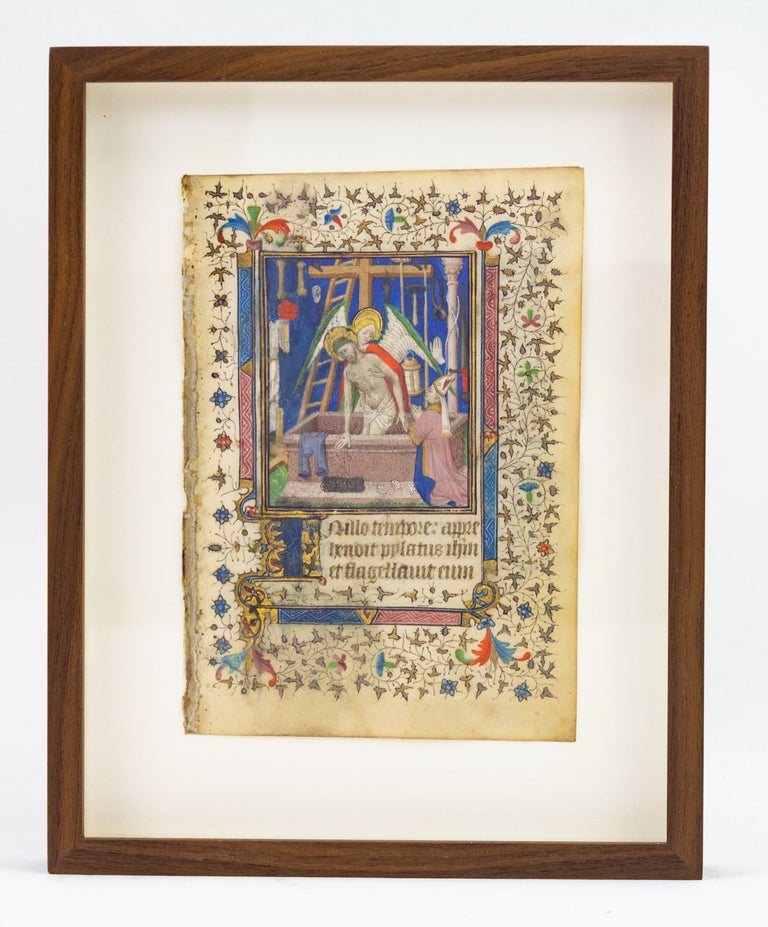
Browse Similar Items
TEXT OPENING THE PASSION ACCORDING TO ST. JOHN.
(Paris: ca. 1415-20). Leaf: 160 x 110 mm. (6 1/4 x 3/8"); Frame: 232 x 185 mm. (9 1/8 x 7 1/4"). Recto with three lines, single column, in a gothic book hand (verso not inspected due to frame).
Mounted in a wooden frame. Recto with a three-line initial in blue on gold ground embellished with ivy leaves, A HALF-PAGE MINIATURE DEPICTING THE MASS OF ST. GREGORY, the recently crucified Christ depicted emerging from a tomb supported by an angel and surrounded by the Arma Christi, St. Gregory kneeling at the corner of the image, the text and miniature framed by thick bar borders of pink, blue, and gold on three sides, all SURROUNDED BY A FULL BORDER of hairline vines, gilt ivy leaves and bezants, and a few colorful flowers and acanthus. ◆A little faint smudging in top and bottom borders, very small (scarcely noticeable) area of blue background retouched (not affecting the figures), but A BEAUTIFUL LEAF, the colors bright and the detail in the miniature very well preserved.
Featuring carefully realized detail, intriguing iconography, and artistry that shows a very high degree of skill, this is an important and early example of the work of the Master of the Harvard Hannibal. The subject of the present work is a well-known story about the sixth century Pope Gregory (ca. 540-604), commonly known as St. Gregory the Great. According to legend, Gregory was saying Mass when one of his deacons expressed a doubt in the doctrine of Transubstantiation, whereby the communion bread actually becomes the body of Christ. Gregory prayed to God for a verifying sign, whereupon Christ appeared in the guise of the Man of Sorrows, clad in a loincloth and displaying the bloody wounds he incurred during the Crucifixion. Most Medieval miniatures depict Gregory kneeling before an altar as he says Mass, accompanied by one or more deacons or assistants who bear witness to the miraculous event. In a notable departure from this norm, the present miniature depicts the saint alone at the edge of the picture plane; in place of the chalice, host, and altar that would normally occupy the center of the scene is a considerable, open tomb from which a larger-than-life-size Christ emerges. With blood still rushing from his wounds, he places one hand on the edge of the tomb to steady himself while an angel supports him from behind. Christ's expression conveys both physical and mental pain as he struggles to support his own bodyweight; the angel who assists him spreads his wings protectively around the body of Christ, while looking down at Gregory with a sorrowful expression knitted into his brow. The fine detail work seen in the figures' faces, the angel's wings, and the careful delineation of each slender finger is also carried over into more than a dozen objects crammed into the spaces in and around the tomb (the rope is especially remarkable in the representation of its detail). Known as the "Arma Christi," or "Instruments of the Passion," these objects are meant to symbolize Christ's suffering. Seen here are: the cross, nails, and hammer that were used to crucify Christ, the ladder used in the Deposition, the disembodied hand symbolizing the one which slapped Christ's face, the dice used by soldiers to see who would claim his seamless robe, a lantern used by the soldiers who arrested Christ, the 30 pieces of silver from Judas' betrayal, a purple robe used in the mockery of Christ, and other items that appear as part of the Passion narrative. It is also interesting to note that although a St. Gregory miniature usually appears at the beginning of the Hours of the Cross, the Penitential Psalms, or before the Seven Prayers of St. Gregory, here, rather unusually, it opens a reading from John chapter 19 (beginning "In illo tempore adprehendit Pilatus Iesum et flagellavit"), describing the events of the Passion. This miniature can be attributed to an artist known as the Master of the Harvard Hannibal, so-named for a splendid miniature painting of the "Coronation of Hannibal" prefacing a Livy in the Harvard College Library. Active from about 1415-30 in Paris (and later possibly Rouen), it is believed that our illuminator was a pupil of the Boucicaut Master, with whom he is thought to have collaborated on several manuscripts, both secular and religious. The present miniature would probably have been executed early in his career, and while it certainly shows the influence of his teacher, it also reveals certain stylistic tendencies that would become staples of the Master of the Harvard Hannibal's more mature work, such as his preference for rich colors, heavy molding of the faces, and interest in decorative details. With its clever composition, meticulous detail work, and emotive figures that engage the viewer, the present miniature is not only a beautiful work of art, it also documents the precocious talent of an emerging master early in his professional career. (ST17763)
Price: $18,000.00
